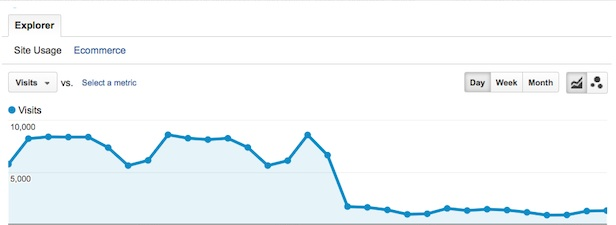Google Analytics is a fantastic tool for those looking to understand how their website is performing (or not). There’s so much valuable information and quite a lot of info that’s less than useful, screen resolution, operating systems, Flash version etc.
However, one metric seems to cause more confusion and fear than all the others combined, it’s called the Bounce Rate (BR).
It’s displayed front and centre when you access Analytics, shouting a percentage at you but what’s good, what’s bad and what does it all mean?
First off, the Bounce itself – it’s simply a record of visitors to your site who left from the page they landed on, without doing anything else. If your BR is below 20% then your website is performing exceptionally well and if it’s around 50% or more then it needs investigating because your website could be leaking a lot of potential customers.
Bounces occur for a variety of reasons;
Site Speed
Research demonstrates that you have about 3 seconds to get your web pages open in front of your visitors. Any slower and they’ll head back to their search engine. Google Analytics provides a lot of information and help if your site is slow.
Setting Expectations
If someone visits your website after seeing or hearing something, and they have an expectation, then if your website fails to meet that expectation, then they’ll leave – hearing about a special offer that’s not plainly displayed on the home page, for example, will increase your BR.
Arriving from an international location and finding the site isn’t in the visitors language increases your BR as does coming from a mobile phone to a non-responsive site, for example.
What to do if you have a high Bounce Rate
If you have a high BR you need to understand why, you should look at the following areas:
- Analytics Site Speed Checker to help you to understand how quickly your site opens and give hints and tips to ways to improve performance.
- Audience to help you to see whether visits come from countries you trade in
- Mobile to see whether mobile users are having a good experience
- Acquisition to show you how your visitors found you
Sometimes there’s nothing you can do, getting a lot of visitors from countries that you don’t trade with, for example. You can’t stop them visiting your site although it might be worth exploring whether this could be a business opportunity.
Then there’s Referrer Spam which can also be called “reverse marketing”. Companies actually target Google Analytics in the hope that they’ll appear high up in your Acquisition/All Traffic stats, pique your interest and encourage you to visit their website in the hope of enticing you into parting with money to buy their services. Treat these with extreme caution as most of the services on offer are poor and may even result in the fraudulent use of credit/debit card data.
You might see names such as “Semalt”, “Buttons-for-websites”, “rankings-analytics” appearing in quite high numbers and they’ll all have 100% bounce rates and 1 Page per Session.
The solution is to set a filter so that Analytics stops counting them and you can do this in the Admin section, under “Filters”. You’ll probably need to set new filters on a monthly basis, so fast do these companies adapt, and a filter only works from the day you implemented it which means that it won’t act on historical data, but at least the data more accurately reflects reality going forwards.
If you are not using Analytics, you should be and if you don’t understand Analytics, you should and if you need any help installing Analytics or want to understand more then get in touch, andy@enterprise-oms.co.uk or give me a call on 01793 238020

